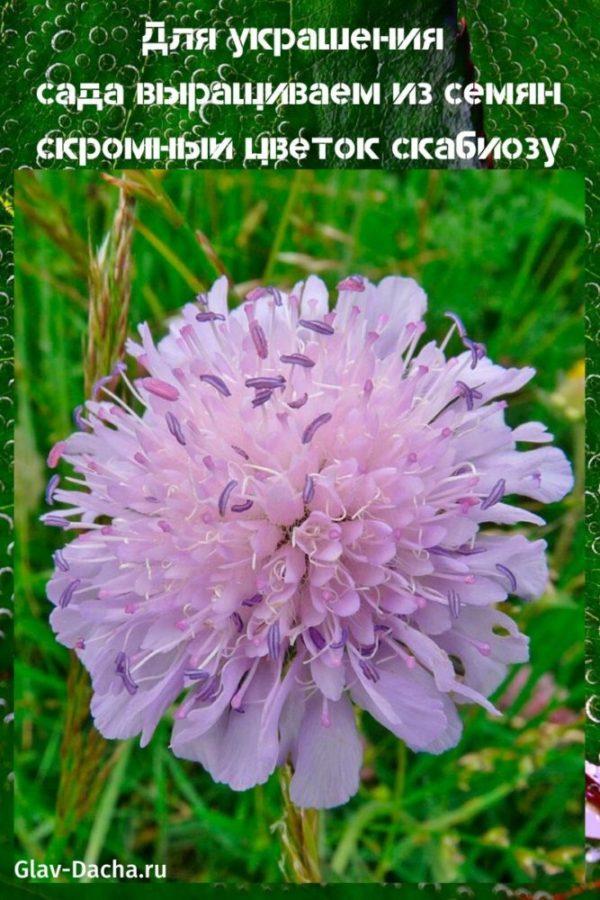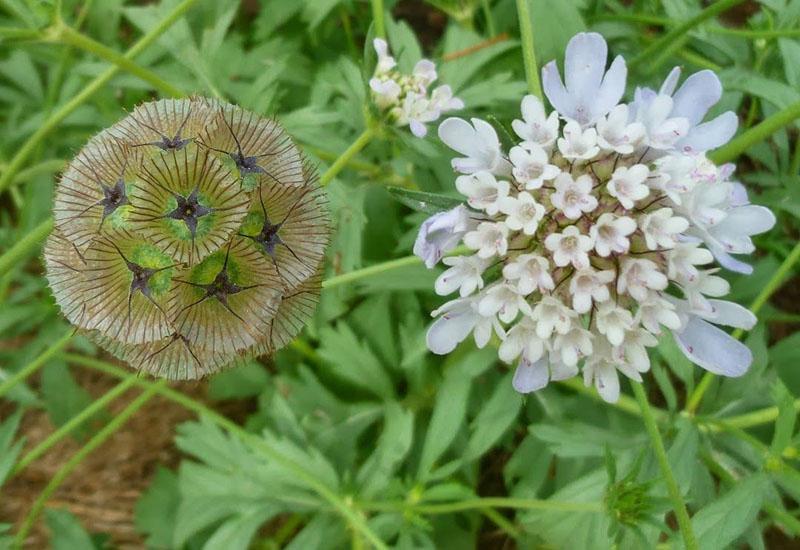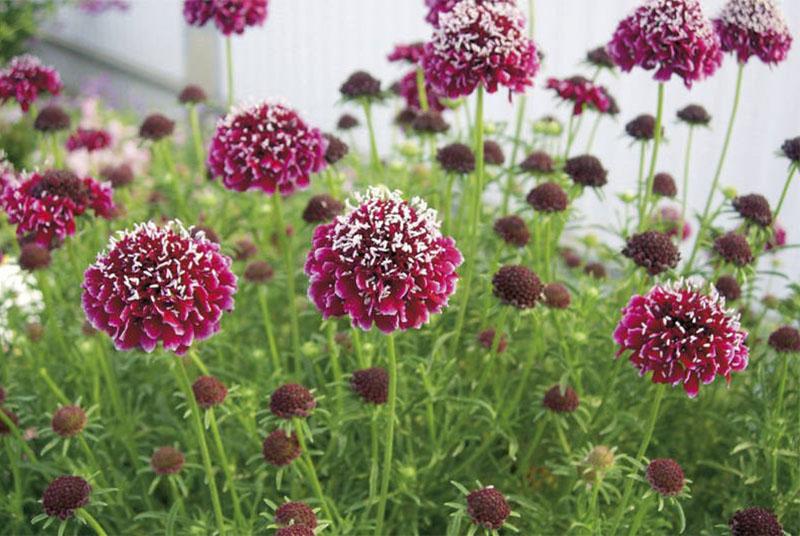To decorate the garden, we grow a modest scabiosu flower from seeds
 Increasingly, an unpretentious guest from warm regions - scabiosa - appears in summer cottages. Growing scabiosa from seeds is a fairly simple matter, so even a young admirer of flora can acquire such beauty. The flower has a unique ability to withstand extreme weather conditions. He is not afraid of cold northern winds. Scabiosa easily tolerates summer heat and drought. Her luxurious buds look original in gift bouquets, on flower beds and pots.
Increasingly, an unpretentious guest from warm regions - scabiosa - appears in summer cottages. Growing scabiosa from seeds is a fairly simple matter, so even a young admirer of flora can acquire such beauty. The flower has a unique ability to withstand extreme weather conditions. He is not afraid of cold northern winds. Scabiosa easily tolerates summer heat and drought. Her luxurious buds look original in gift bouquets, on flower beds and pots.
Biological features of culture

 As in the natural environment, and in the backyard flower beds, the flower grows up to 100 cm in height. Strong erect stems are decorated with pinnately dissected leaf plates. They are arranged oppositely, thereby emphasizing the beauty of the buds.
As in the natural environment, and in the backyard flower beds, the flower grows up to 100 cm in height. Strong erect stems are decorated with pinnately dissected leaf plates. They are arranged oppositely, thereby emphasizing the beauty of the buds.
 Miniature flowers are tightly collected in capitate inflorescences, which are oval or flattened. The buds are crowned with slender peduncles and are surrounded by rough foliage.
Miniature flowers are tightly collected in capitate inflorescences, which are oval or flattened. The buds are crowned with slender peduncles and are surrounded by rough foliage.
The rim is funnel-shaped. It is formed by five fused delicate petals. The buds located at the edges are slightly larger than the rest, which makes the plant unique. After successful pollination, fruits appear. Inside are small light brown oval seeds.
The planting material of the scabiosa plant remains viable for 4 years.
Varieties of an elegant flower
 Biologists count about 100 types of scabiosa. Each of them has its own unique shape, color and aroma. Therefore, any option is suitable for decorating a summer cottage. Let's consider the most popular varieties.
Biologists count about 100 types of scabiosa. Each of them has its own unique shape, color and aroma. Therefore, any option is suitable for decorating a summer cottage. Let's consider the most popular varieties.
Caucasian scabiosa
 The flower belongs to the mountain species. It is found in group or single plantings on mountain slopes, along the banks of rivers and lakes. The maximum crop height is 1 m. It has large inflorescences of various lilac shades.
The flower belongs to the mountain species. It is found in group or single plantings on mountain slopes, along the banks of rivers and lakes. The maximum crop height is 1 m. It has large inflorescences of various lilac shades.
Hybrid options are:
- red;
- blue;
- white;
- pink.
The buds bloom in early July, and this continues until the onset of autumn.
Popular subspecies of Caucasian scabiosa:
- Fama;
- Compliment;
- Perfect;
- Nachtfalter.
The culture is grown along the garden paths. Used in registration alpine slides and mixborders. Salt compositions are grown in pots.
The plant retains its pristine beauty in slices for a long time.
Japanese
 The homeland of the culture is the country of the same name, where it is grown in urban flower beds. Perennial Japanese scabiosa grows up to 60 cm. Some variants reach only 20 cm. The flower miraculously tolerates cold and winter cold. The buds are colored in various shades of pink and red. The maximum diameter of the inflorescence is approximately 5 cm. The variety is used to create stylish landscapes in the backyard.
The homeland of the culture is the country of the same name, where it is grown in urban flower beds. Perennial Japanese scabiosa grows up to 60 cm. Some variants reach only 20 cm. The flower miraculously tolerates cold and winter cold. The buds are colored in various shades of pink and red. The maximum diameter of the inflorescence is approximately 5 cm. The variety is used to create stylish landscapes in the backyard.
Yellow scabiosa
 Wild scabiosa with bright, sunny buds is listed in the Red Book.The cultivated perennial is distinguished by erect stems that rapidly reach the sky. Some specimens reach a height of one meter. The first buds bloom in mid-summer, the last in early autumn. The crop is planted around the edges of the flower bed to create a stylish backdrop for the brighter plants.
Wild scabiosa with bright, sunny buds is listed in the Red Book.The cultivated perennial is distinguished by erect stems that rapidly reach the sky. Some specimens reach a height of one meter. The first buds bloom in mid-summer, the last in early autumn. The crop is planted around the edges of the flower bed to create a stylish backdrop for the brighter plants.
Purple
 The species is often grown as an annual crop. It is distinguished by pubescent shoots up to 110 cm high.
The species is often grown as an annual crop. It is distinguished by pubescent shoots up to 110 cm high.
They are crowned with large buds up to 8 cm in diameter, painted in the following colors:
- maroon;
- pink;
- blue.
Some specimens have an almost black appearance. For this, the Europeans called the purple scabiosa "flower of mourning." Popular varieties include "Blue Moon", "Monarch Cockade", "Rose".
Purple scabiosa does not like the cold, so it should not be grown in the middle lane, where there are severe winters.
Terry scabiosa
 This species can rightfully be called collective.
This species can rightfully be called collective.
It includes varieties popular for landscape design:
- Fruit ice;
- Crystal;
- Lavender lady.
The color scheme is very diverse, from white to dark purple and red tones. The culture is used for making bouquets and decorating personal plots.
Growing scabiosa from seeds in the open field and for seedlings
 The southern beauty is confidently mastering the summer cottages of our compatriots. They grow it mainly by sowing seeds. The plant is sown directly on the flower bed in April, when the threat of frost is reduced to zero. If the spring is long and cold, seedlings are grown. The process starts around mid-March. Consider the technology of growing scabiosa flowers from seeds in the open field and for seedlings.
The southern beauty is confidently mastering the summer cottages of our compatriots. They grow it mainly by sowing seeds. The plant is sown directly on the flower bed in April, when the threat of frost is reduced to zero. If the spring is long and cold, seedlings are grown. The process starts around mid-March. Consider the technology of growing scabiosa flowers from seeds in the open field and for seedlings.
Create a spectacular flower bed
 First of all, choose a suitable place. Since the plant loves an abundance of light and space, elevated areas will do. However, the flower bed must be protected from drafts.
First of all, choose a suitable place. Since the plant loves an abundance of light and space, elevated areas will do. However, the flower bed must be protected from drafts.
For annual varieties, the type of soil does not play a special role, but it is better to sow perennials in loose fertile soil.
On a land with a high acidity, scabiosa loses its decorative effect and quickly dies.
Then they think over which cultures will be the best neighbors for the southern beauty. She develops wonderfully in the company:
- peonies;
- anaphalis;
- asters;
- monards;
- Iberis.
 When the plan is drawn up, they begin to prepare the site. 2 weeks before sowing, the crops are removed from the remnants of last year's weeds and thoroughly plowed the land. The top layer is leveled and shallow holes are made at a distance of 35-40 cm. The earth is slightly moistened with a spray bottle. Then spread the seeds at intervals of about 5 cm and sprinkle with loose soil. After 15 days, sprouts will appear. When they get stronger, the flowers are thinned out.
When the plan is drawn up, they begin to prepare the site. 2 weeks before sowing, the crops are removed from the remnants of last year's weeds and thoroughly plowed the land. The top layer is leveled and shallow holes are made at a distance of 35-40 cm. The earth is slightly moistened with a spray bottle. Then spread the seeds at intervals of about 5 cm and sprinkle with loose soil. After 15 days, sprouts will appear. When they get stronger, the flowers are thinned out.
To get spots on the buds, the seeds are scattered throughout the flower bed in a chaotic manner.
Seedling preparation
 A troublesome, but quite effective way of growing scabios from seeds at home, suitable for residents of mid-latitudes. In early March, they begin an interesting process. Drainage from a suitable material is placed at the bottom of the spacious boxes.
A troublesome, but quite effective way of growing scabios from seeds at home, suitable for residents of mid-latitudes. In early March, they begin an interesting process. Drainage from a suitable material is placed at the bottom of the spacious boxes.
This could be:
- pebbles;
- expanded clay;
- broken brick.
A fertile substrate is poured on top and lightly tamped. With the help of a ruler, they make grooves, moisten and spread the planting material. Sprinkle with soil and water again. The boxes are covered with foil and taken to a room where there is an abundance of light. Small containers are placed on the windowsills.
Crops are set away from drafts.
 In order for the seedlings to develop successfully, a dose of oxygen is daily allowed into the miniature greenhouse. After about 7-9 days, the film is completely removed. When 3 leaf plates appear on the seedlings, they are transplanted into separate pots. A few days before disembarkation, the scabiosa is taken out into the street to harden. At the end of spring, they are transferred to open ground.
In order for the seedlings to develop successfully, a dose of oxygen is daily allowed into the miniature greenhouse. After about 7-9 days, the film is completely removed. When 3 leaf plates appear on the seedlings, they are transplanted into separate pots. A few days before disembarkation, the scabiosa is taken out into the street to harden. At the end of spring, they are transferred to open ground.
Perennials are propagated using root cuttings in the classical way.
Secrets of competent care
 As practice shows, planting scabiosa and leaving in the open field requires a reasonable sequence. The main reason is areoles living in their natural environment. The southern beauty does not like excessive moisture. Therefore, it is moistened as the topsoil dries out. In the absence of precipitation, about 0.5 liters of water is poured under each bush. The resulting crust is periodically loosened, while removing weeds.
As practice shows, planting scabiosa and leaving in the open field requires a reasonable sequence. The main reason is areoles living in their natural environment. The southern beauty does not like excessive moisture. Therefore, it is moistened as the topsoil dries out. In the absence of precipitation, about 0.5 liters of water is poured under each bush. The resulting crust is periodically loosened, while removing weeds.
 Top dressing is carried out once every 15 days. For this, special ready-made mixtures are used, which are sold in flower shops. Organic substances are introduced into the soil in early spring just before planting seedlings or sowing seeds.
Top dressing is carried out once every 15 days. For this, special ready-made mixtures are used, which are sold in flower shops. Organic substances are introduced into the soil in early spring just before planting seedlings or sowing seeds.
Scabiosa pruning is done as the peduncles dry. They are removed immediately after flowering. As a result, young shoots appear on the culture.
The seeds are harvested in early autumn. They choose ripe and large specimens without flaws. Only perennial flowers are prepared for winter. First, all shoots are completely cut off. Then a dry straw shelter is prepared (only in regions with cold winters). In the spring, the plant will again dissolve bright buds to the delight of all people.
As our research shows, growing scabiosa from seeds is very interesting. There are 2 ways: direct sowing in open ground or in containers for seedlings. Any kind of flower can be cultivated. The main thing is to adhere to the principles that gardeners have developed.
Growing scabiosa from seeds from A to Z - video